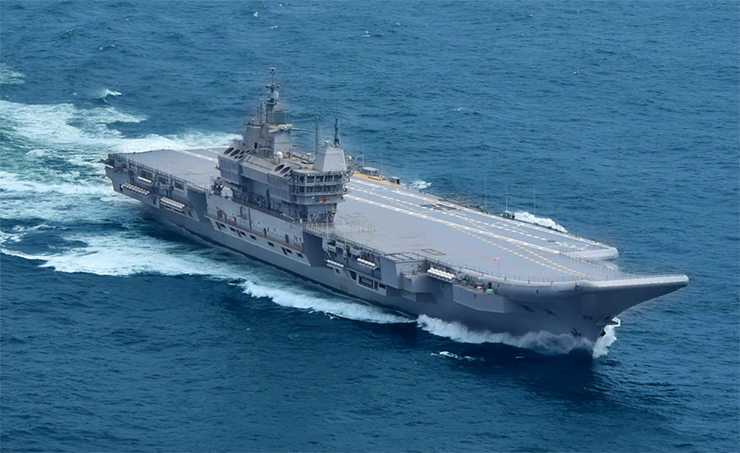
Alfred Thayer Mahan, the renowned naval strategist and a former admiral of the American Navy, said, “Sea power is the key to the building up of an empire”. Perhaps the commissioning of India’s first indigenously built aircraft carrier Vikrant, points to the changing notion of New Delhi’s foreign maritime policy. The induction of INS Vikrant into the Indian Navy has catapulted India into the select league of countries which have deployed aircraft carriers such as France, Russia, the USA, China and the UK.
Prioritizing the maritime domain
India’s first indigenously built aircraft carrier points to India giving increasing importance to the seas. This was not so all the time. After independence from colonial rule in 1947, India under successive prime ministers concentrated on its economic development and self-reliance, and in that process, neglected its defence. The first shock came from China in the 1962 Indo-China war, which convinced New Delhi that it is imperative to be militarily strong notwithstanding the fact that the mandarins of foreign policy at that time perceived military spending as at most, a necessary evil. The importance of dominating the maritime domain came with the US-Soviet faceoff during the third Indo-Pak war of 1971 when the Soviet Union deployed its own carrier strike force to deal with the formidable Pacific fleet of the American Navy. However, India’s maritime goals remained neglected until the Modi government came to power in 2014.
Indian strategic thinking was predominantly continental threat-oriented due to the presence of two hostile neighbours along its northern and western borders. However, the 26/11 terror attacks gave a new shock to the Indian strategic establishment to give priority to the maritime domain. Since then, many changes have taken place, with India developing a strong coast guard, putting in place a strong maritime surveillance network along the coastal areas for better protection of the exclusive economic zone of New Delhi. To give increasing attention to the Indo-Pacific region, Prime Minister Modi introduced the SAGAR (Security and Growth for All in the Region) on a visit to the Maldives in 2015. Two years later, India played a key role in reviving the Quad or the Quadrilateral security grouping to contain Chinese presence in the Indian Ocean Region in general and Indo-Pacific in particular.
The maritime domain for India is vital. It accounts for 95% of overseas trade by volume and 70% by value. According to Dhruv Jaishankar, if the Indo-Pacific region is dominated by a foreign power hostile to India, it will jeopardize Indian interests.
Contestation to intensify
Following the procurement of INS Vikrant, the Indian government and Navy is actively considering a third aircraft carrier. Some commentators have argued that the aircraft carriers are white elephants, which in the age of artificial intelligence can be taken down by sophisticated, yet cost-effective Surface-to-air missiles, torpedoes, and ballistic missiles; their loss will deal a decisive blow in times of war. However, others argue that the aircraft carriers are a symbol of the hard power of the nation. This is particularly relevant in the Indo-Pacific domain where China is flexing its military muscles. It is very clear that India will send its carrier strike force comprising destroyers, frigates, submarines and this prized warship to not only protect its “national interests” but also to enforce freedom of navigation. A potential area of contestation in the Indo-Pacific is the Indian Ocean Region which is India’s backyard.
The arrival of the Yuan Wang 5 Chinese surveillance ship in Hambantota port and India’s concern over its arrival followed by the sharp exchange of words between the two countries, is a testimony to India zealously guarding its interests.
There is little doubt that the contest between the Indian and Chinese navies will intensify in the Indo-Pacific region in the coming years. China already has two aircraft carriers- Liaoning and Shandong, and a third one is in the making. Hence it is imperative that New Delhi keep its razor-sharp focus on the maritime region. Procurement of nuclear submarines, stealth frigates, stealth-based hypersonic missiles, and aircraft carriers should be the objective of New Delhi.
Conclusion
Having bolstered its maritime arsenal, India should focus on jettisoning or not joining any military alliances. It should concentrate on building a dedicated maritime military alliance, something like the Asian naval NATO, which will be committed to the protection of the world’s seas and strategic choke points. Also, India should focus on changing its perception that only continental threats are potent, as the maritime domain is equally important. Only by laying increasing emphasis on militarising itself can India afford to move up on the great power ladder.
– The writer is currently working as a Research Associate at Defence Research and Studies (dras.in) and is a columnist. The views expressed are personal and do not necessarily reflect the views of Raksha Anirveda









